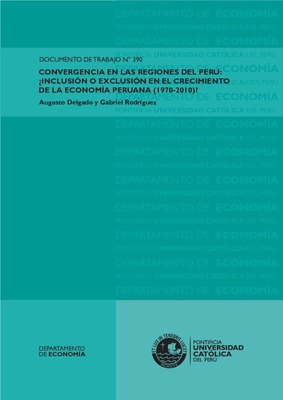| dc.contributor.author | Delgado, Augusto | |
| dc.contributor.author | Rodríguez, Gabriel | |
| dc.date.accessioned | 2015-03-19T20:37:58Z | |
| dc.date.available | 2015-03-19T20:37:58Z | |
| dc.date.issued | 2014 | |
| dc.identifier.uri | http://repositorio.pucp.edu.pe/index/handle/123456789/47031 | |
| dc.description.abstract | La economía peruana ha venido creciendo sostenidamente en los últimos 15 años. Verificar si los departamentos (o regiones) han logrado un proceso de convergencia ya sea hacia un solo estado estacionario o a su propio estado estacionario sería equivalente a verificar un proceso de inclusión en dicho proceso de crecimiento. Características básicas del Censo nacional permiten afirmar que existen un buen número de departamentos que aún no alcanzan ciertos criterios mínimos de subsistencia y por lo tanto se encuentran en un claro proceso de exclusión. Desde esta perspectiva, pensamos que el concepto de convergencia puede proporcionarnos algunas luces sobre esta situación. Si la convergencia existe, es probable que dicha convergencia se realice hacia la pobreza o exclusión. En este documento se realizan diferentes pruebas estadísticas para verificar la existencia de convergencia estocástica y determinística, así como la aplicación de una reciente metodología para la identificación de los denominados clubes de convergencia. Los resultados de la aplicación de los test de raíz unitaria sin quiebre estructural indican la inexistencia de convergencia estocástica. Sin embargo, al incorporar la presencia de quiebres endógenos el resultado se revierte para todos los departamentos a excepción de Huancavelica. La aplicación de un estadístico robusto a la presencia de errore I(0) e I(1) permite estimar las tasas de crecimiento departamentales antes y después del quiebre. Los resultados sugieren que mayoritariamente los departamentos han acelerados sus tasas de crecimiento después del punto de quiebre. Algunos departamentos muestran inexistencia de cambio estructural y unos pocos casos muestran una desaceleración de sus tasas de crecimiento. Por otro lado, se ha encontrado evidencia de la formación de clubes de convergencia robustos a diferentes ordenamientos propuestos por la metodología utilizada. Según esta metodología los departamentos de Apurímac y Huancavelica no forman parte de ningún club de convergencia lo que equivale a decir que están desconectados del resto del país. | es_ES |
| dc.description.abstract | The Peruvian economy has been growing steadily over the past 15 years. Check if the departments have achieved a convergence process either to a single steady state or its own steady state would be an indicator to verify a process of inclusion in the growth process. Basic features of the national census are such that there are a number of departments not reach certain minimum criteria for subsistence and therefore are in a clear process of exclusion. From this perspective, the concept of convergence may provide some light on this situation. If convergence exists, it is likely that this convergence is carried into poverty or exclusion or to the opposite side. In this paper, per capita GDP of each department relative to the national average is used to apply various statistical tests in order to verify the existence of stochastic convergence and β-convergence as well. Further, the application of a new methodology for identifying clubs convergence is used. The results of the application of unit root tests without structural change indicate the absence of stochastic convergence. However, incorporating the presence of endogenous breaks, the result is reversed for all departments. The implementation of a statistical test robust to the presence of I (0) or I (1) errors allows inference from estimates of the intercepts and growth rates before and after a structural break. The results indicate that all departments have experienced a structural break in the period 1970-2010. The analysis of the intercepts and growth rates before and after the breakpoint suggests that the departments that have undergone a process of catching-up and those who have undergone a process of lagging-behind. In some cases this process of lagging-behind has been given to levels below the national average while other departments have remained above the national average. On the other hand, besides rejecting absolute convergence hypothesis, we found three clubs of convergence. There are also two departments (Apurimac and Huancavelica) that are not part of any club convergence and appear disconnected from the rest of the country and stuck to GDP per capita average. | en_US |
| dc.language.iso | spa | es_ES |
| dc.publisher | Pontificia Universidad Católica del Perú. Departamento de Economía | es_ES |
| dc.relation.ispartof | urn:issn:2079-8466 | |
| dc.relation.ispartof | urn:issn:2079-8474 | |
| dc.relation.ispartofseries | Documento de Trabajo;390 | es_ES |
| dc.rights | info:eu-repo/semantics/openAccess | es_ES |
| dc.rights.uri | http://creativecommons.org/licenses/by-nc-nd/2.5/pe/ | * |
| dc.subject | Convergencia | es_ES |
| dc.subject | Inclusión | es_ES |
| dc.subject | Clubes de convergencia | es_ES |
| dc.subject | PBI | es_ES |
| dc.subject | Per cápita | es_ES |
| dc.title | Convergencia en las Regiones del Perú: ¿Inclusión o Exclusión en el Crecimiento de la Economía Peruana (1970-2010)? | es_ES |
| dc.title.alternative | Convergence in Peruvian regions: Inclusion or exclusion in Peruvian economic growth? | en_US |
| dc.type | info:eu-repo/semantics/workingPaper | |
| dc.type.other | Documento de trabajo | |
| dc.subject.ocde | http://purl.org/pe-repo/ocde/ford#5.02.00 | |
| dc.publisher.country | PE | |
| renati.advisor.orcid | https://orcid.org/0000-0003-1174-9642 | |


